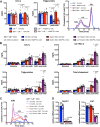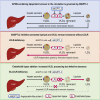Angiopoietin-like protein 3 governs LDL-cholesterol levels through endothelial lipase-dependent VLDL clearance
- PMID: 32646941
- PMCID: PMC7469887
- DOI: 10.1194/jlr.RA120000888
Angiopoietin-like protein 3 governs LDL-cholesterol levels through endothelial lipase-dependent VLDL clearance
Abstract
Angiopoietin-like protein (ANGPTL)3 regulates plasma lipids by inhibiting LPL and endothelial lipase (EL). ANGPTL3 inactivation lowers LDL-C independently of the classical LDLR-mediated pathway and represents a promising therapeutic approach for individuals with homozygous familial hypercholesterolemia due to LDLR mutations. Yet, how ANGPTL3 regulates LDL-C levels is unknown. Here, we demonstrate in hyperlipidemic humans and mice that ANGPTL3 controls VLDL catabolism upstream of LDL. Using kinetic, lipidomic, and biophysical studies, we show that ANGPTL3 inhibition reduces VLDL-lipid content and size, generating remnant particles that are efficiently removed from the circulation. This suggests that ANGPTL3 inhibition lowers LDL-C by limiting LDL particle production. Mechanistically, we discovered that EL is a key mediator of ANGPTL3's novel pathway. Our experiments revealed that, although dispensable in the presence of LDLR, EL-mediated processing of VLDL becomes critical for LDLR-independent particle clearance. In the absence of EL and LDLR, ANGPTL3 inhibition perturbed VLDL catabolism, promoted accumulation of atypical remnants, and failed to reduce LDL-C. Taken together, we uncover ANGPTL3 at the helm of a novel EL-dependent pathway that lowers LDL-C in the absence of LDLR.
Keywords: atherosclerosis; cardiovascular disease; familial hypercholesterolemia; lipidomics; low density lipoprotein receptor; low density lipoprotein-cholesterol; very low density lipoprotein.
Copyright © 2020 Adam et al. Published by The American Society for Biochemistry and Molecular Biology, Inc.
Conflict of interest statement
Conflict of interest—R.C.A., I.J.M., C.A.A-B., L.M.S., J.S.L., P.B., S.C.H., H.I.K., C.V.H., G.D.Y., A.J.M., J.G., M.W.S. and V.G. are or were employees and stockholders at Regeneron Pharmaceuticals while engaged in this study. All other authors declare that they have no conflicts of interest with the contents of this article.
Figures






References
-
- Hegele R. A. 2009. Plasma lipoproteins: genetic influences and clinical implications. Nat. Rev. Genet. 10: 109–121. - PubMed
-
- Goldstein J. L., Hobbs H. H., and Brown M. S.. 2001. Familial hypercholesterolemia. In The Metabolic and Molecular Bases of Inherited Disease. 8th edition. C. R. Scriver, A. L. Beaudet, W. S. Sly, et al., editors. McGraw-Hill, Inc.; New York. 2863–2913.
-
- Kersten S. 2019. New insights into angiopoietin-like proteins in lipid metabolism and cardiovascular disease risk. Curr. Opin. Lipidol. 30: 205–211. - PubMed
MeSH terms
Substances
Grants and funding
LinkOut - more resources
Full Text Sources
Other Literature Sources
Medical
Molecular Biology Databases
Miscellaneous

